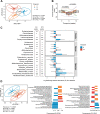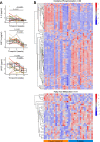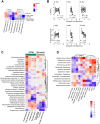Metabolite-based dietary supplementation in human type 1 diabetes is associated with microbiota and immune modulation
- PMID: 35045871
- PMCID: PMC8772108
- DOI: 10.1186/s40168-021-01193-9
Metabolite-based dietary supplementation in human type 1 diabetes is associated with microbiota and immune modulation
Abstract
Background: Short-chain fatty acids (SCFAs) produced by the gut microbiota have beneficial anti-inflammatory and gut homeostasis effects and prevent type 1 diabetes (T1D) in mice. Reduced SCFA production indicates a loss of beneficial bacteria, commonly associated with chronic autoimmune and inflammatory diseases, including T1D and type 2 diabetes. Here, we addressed whether a metabolite-based dietary supplement has an impact on humans with T1D. We conducted a single-arm pilot-and-feasibility trial with high-amylose maize-resistant starch modified with acetate and butyrate (HAMSAB) to assess safety, while monitoring changes in the gut microbiota in alignment with modulation of the immune system status.
Results: HAMSAB supplement was administered for 6 weeks with follow-up at 12 weeks in adults with long-standing T1D. Increased concentrations of SCFA acetate, propionate, and butyrate in stools and plasma were in concert with a shift in the composition and function of the gut microbiota. While glucose control and insulin requirements did not change, subjects with the highest SCFA concentrations exhibited the best glycemic control. Bifidobacterium longum, Bifidobacterium adolescentis, and vitamin B7 production correlated with lower HbA1c and basal insulin requirements. Circulating B and T cells developed a more regulatory phenotype post-intervention.
Conclusion: Changes in gut microbiota composition, function, and immune profile following 6 weeks of HAMSAB supplementation were associated with increased SCFAs in stools and plasma. The persistence of these effects suggests that targeting dietary SCFAs may be a mechanism to alter immune profiles, promote immune tolerance, and improve glycemic control for the treatment of T1D.
Trial registration: ACTRN12618001391268. Registered 20 August 2018, https://www.anzctr.org.au/Trial/Registration/TrialReview.aspx?id=375792 Video Abstract.
Keywords: Autoimmunity; Dietary-metabolites; Immune regulation; Microbiota; SCFAs; Type 1 diabetes.
© 2022. The Author(s).
Conflict of interest statement
The authors declare no competing interests.
Figures






Comment in
-
Microbial influencers: treating diabetes through the gut.Immunol Cell Biol. 2022 Jul;100(6):390-393. doi: 10.1111/imcb.12558. Epub 2022 Jun 8. Immunol Cell Biol. 2022. PMID: 35599627
References
-
- Thorburn AN, Macia L, Mackay CR. Diet, metabolites, and "Western-lifestyle" inflammatory diseases. Immunity. 2014;40(6):833–842. - PubMed
-
- de Goffau MC, Fuentes S, van den Bogert B, Honkanen H, de Vos WM, Welling GW, Hyoty H, Harmsen HJ. Aberrant gut microbiota composition at the onset of type 1 diabetes in young children. Diabetologia. 2014;57(8):1569–1577. - PubMed
-
- Zhao L, Zhang F, Ding X, Wu G, Lam YY, Wang X, Fu H, Xue X, Lu C, Ma J, et al. Gut bacteria selectively promoted by dietary fibers alleviate type 2 diabetes. Science. 2018;359(6380):1151–1156. - PubMed
-
- Mariño E, Richards JL, McLeod KH, Stanley D, Yap YA, Knight J, McKenzie C, Kranich J, Oliveira AC, Rossello FJ, et al. Gut microbial metabolites limit the frequency of autoimmune T cells and protect against type 1 diabetes. Nature immunology. 2017;18(5):552–562. - PubMed
Publication types
MeSH terms
Substances
LinkOut - more resources
Full Text Sources
Medical
Molecular Biology Databases

